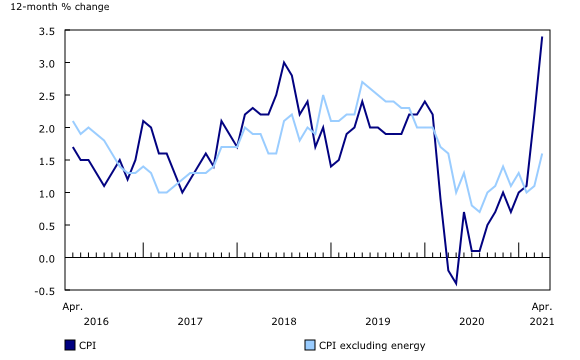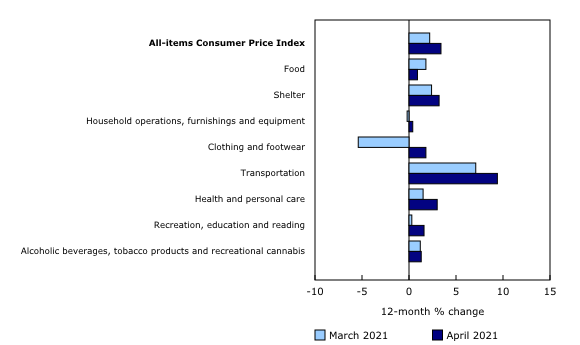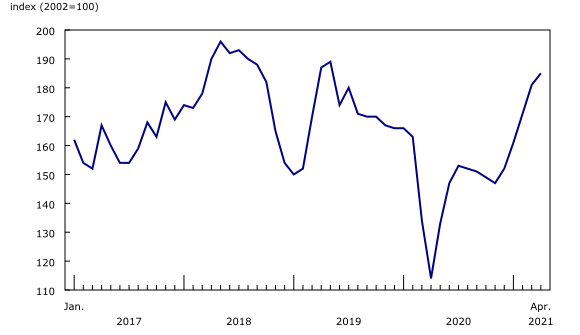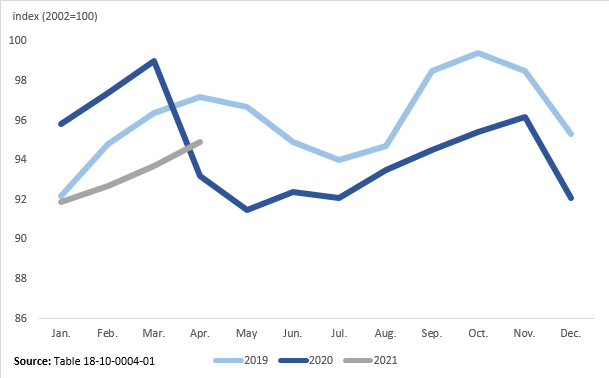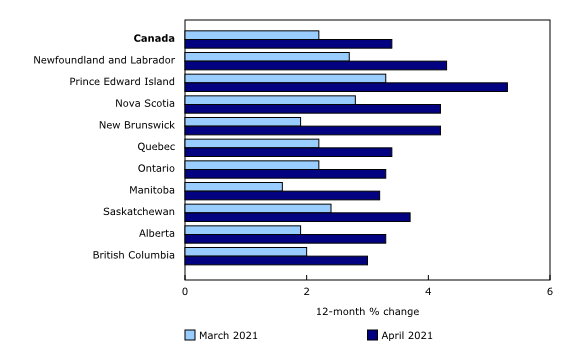Consumer Price Index, April 2021
Archived Content
Information identified as archived is provided for reference, research or recordkeeping purposes. It is not subject to the Government of Canada Web Standards and has not been altered or updated since it was archived. Please "contact us" to request a format other than those available.
Released: 2021-05-19
April 2021
3.4% 
(12-month change)
The Consumer Price Index (CPI) rose 3.4% on a year-over-year basis in April, up from a 2.2% gain in March. A significant proportion of this increase was attributable to a steep decline in prices in April 2020, as the monthly CPI rose 0.5% in April 2021. On a seasonally adjusted monthly basis, the CPI rose 0.6% in April. Excluding energy, the CPI was up 1.6% year over year in April, following a 1.1% increase in March.
In April 2020, the headline CPI fell 0.2% year over year—the first CPI decline in over a decade. As a result of the broad decrease in prices in 2020, base-year effects continued to have an upward impact on consumer inflation, contributing to the strong acceleration in April 2021.
Base-year effects and the CPI: The COVID-19 pandemic experience
The Consumer Price Index (CPI) is a standard measure of the price of a representative basket of goods and services. The headline consumer inflation is measured as the percentage change between the CPI in the current month (April 2021) and the CPI in a base month or the same calendar month of the previous year (April 2020).
A base-year effect refers to the impact that price movements from 12 months earlier have on the current month's headline consumer inflation. When a large downward price change in the base month stops influencing—or falls out of—the 12-month price movement, this has an upward effect on the headline CPI in the current month. Conversely, a large upward price change in the base month creates downward pressure on the current month's measure.
In spring 2020, the global economy was dramatically affected by the COVID-19 pandemic and Canadian consumers experienced a significant decline in prices from February to April 2020. Headline consumer inflation slowed from +2.2% in February 2020 to +0.9% in March 2020 and -0.2% in April 2020, the largest two-month slowdown in year-over-year CPI growth since 1992. The broad decline in prices at the onset of the pandemic, led by energy products, had an upward impact on the year-over-year rate of consumer inflation in April 2021, because significantly lower prices from April 2020 were used as the basis for year-over-year comparison.
For instance, gasoline prices were 62.5% higher in April 2021 compared with April 2020, when prices reached an 11-year low in the early weeks of the pandemic.
The upward impact of these base-year effects will be temporary, as price declines observed in April 2020 will fall out of the 12-month price movement. Users should consider the impact of base-year effects when interpreting the 12-month price movement.
Highlights
Year-over-year consumer price growth (+3.4%) in April rose at its fastest pace since May 2011 amid the third wave of the COVID-19 pandemic, mostly because prices fell sharply during the early months of the pandemic. As some regions extended restrictions to limit the spread of COVID-19, causing employment losses for some Canadians, prices grew 0.5% month over month in April 2021, the same growth rate as in March 2021.
Prices rose in every major component on a year-over-year basis. Transportation prices (+9.4%) increased in April, mainly because of higher gasoline prices compared with April 2020.
Gasoline prices rise on base-year effect and lower supply
The price of gasoline rose 62.5% on a year-over-year basis in April, the largest year-over-year increase on record. The gain in gasoline prices was mainly driven by steep price declines in April 2020, when gasoline fell 15.2% month over month as a result of limited travel, temporary business closures, and lower levels of international trade, which created an oversupply of gasoline in the market.
In addition, the rise in gasoline prices was partially attributable to the maintenance of production cuts by OPEC+ countries (countries from the Organization of Petroleum Exporting Countries Plus), amid increased demand.
Shelter prices continue to rise
Shelter prices were up 3.2% year over year in April after rising 2.4% the previous month. The homeowners' replacement cost index (+9.1%) continued to trend upwards, posting its largest gain since April 1989. Higher building costs and demand for single-family homes contributed to an increase in prices for newly built homes.
Spotlight on lumber prices
The forestry industry has a long and rich history in Canada, and is a vital part of the Canadian economy. As one of the world's leading forestry product exporters, Canada meets the needs of consumers in over 180 countries.
The United States is one of the major foreign markets for exports of Canadian wood products. In fact, Canadian lumber prices are strongly influenced by homebuilding demand in the United States. Over the course of the COVID-19 pandemic, demand for new homes with more space increased across North America, and this, in part, contributed to higher lumber prices. This has affected consumer prices in Canada in different ways.
Although lumber is not priced directly in the Consumer Price Index (CPI), it is a key input cost for durable goods such as furniture. Higher raw material prices for lumber, in addition to other cost pressures, can lead to higher prices for consumer products and services in the CPI, such as wooden furniture (+6.9%). Homeowners may also purchase lumber products directly for certain uses, such as building or refurbishing fences and patios—purchases that are measured in the CPI through the homeowners' maintenance and repairs index, which rose 1.0% on a year-over-year basis in April. In addition, rising lumber prices can lead to higher prices for new homes, increasing the costs associated with home ownership, including homeowners' replacement cost (+9.1%).
Given the importance of lumber to the Canadian economy, Statistics Canada will continue to monitor the impact of rising lumber prices on consumer price inflation.
Consumers pay more for clothing and footwear
Clothing and footwear prices were up 1.8% year over year in April, the first 12-month increase since March 2020. Lower prices for clothing and footwear in April 2020 contributed to the year-over-year rise in April 2021. This time last year, retailers nationwide had to adapt to higher inventories associated with a sudden suspension of in-store shopping, resulting in larger online discounts. Contrary to April 2020, retailers in some provinces were able to open at a limited capacity in April 2021.
Food prices increase at a slower pace
Year over year, food prices rose at a slower pace in April (+0.9%) than in March (+1.8%). The slowdown was partly attributable to lower prices for fresh vegetables (-7.2%), as prices for tomatoes fell 29.8% on a year-over-year basis as a result of increased supply.
Higher prices for dry and preserved foods in April 2020, when demand for non-perishable food products heightened as a result of public health measures, had a downward impact on the food price index in April 2021.
Consumers pay less for phone plans year over year
Prices for telephone services, which include cellular services, fell 13.0% year over year in April 2021 and have been declining since September 2019. The price decrease was partially attributable to wireless service providers offering bonus data promotions on some cellular plans throughout the year.
Regional highlights
Prices rose in every province on a year-over-year basis in April. Year-over-year price increases were generally higher in the Atlantic provinces, where furnace fuel oil is more commonly used. Similar to gasoline, fuel oil and other fuels (+20.3%) are subject to oil price dynamics, and prices remained high compared with April 2020.
Electricity prices rise the most in Ontario and Alberta
In Ontario, prices for electricity rose 18.3% compared with April 2020, when the provincial government set all time-of-use electricity prices to the off-peak rate, resulting in lower prices for on-peak and mid-peak electricity usage.
On a year-over-year basis, consumers in Alberta paid 16.9% more for electricity in April 2021. The increase was mainly attributable to lower prices in April 2020, when demand for energy declined during the early stages of the pandemic.
Note to readers
The COVID-19 pandemic and the Consumer Price Index
For more information about the impact of the COVID-19 pandemic on the Consumer Price Index (CPI) during the first year of the pandemic, please consult the research document entitled "The Consumer Price Index and COVID-19: A One-Year Retrospective," published as part of the Prices Analytical Series (62F0014M). This publication explores the sources of pandemic-related price change and the ongoing impact of base-year effects on the headline CPI.
Statistics Canada continues to monitor the impacts of the novel coronavirus (also known as COVID-19) on Canada's CPI.
Goods and services in the CPI that were not available to consumers in April because of COVID-19 restrictions received special treatments, which effectively removed their impact on the monthly CPI. The values for the following sub-indexes were imputed from the monthly change in the all-items index: travel tours, some components of spectator entertainment, recreational services, personal care services in some areas, and some components of use of recreational facilities and services in some areas.
The price indexes for beer served in licensed establishments, wine served in licensed establishments and liquor served in licensed establishments were imputed in several regions, using the indexes to which consumers likely redirected their expenditures: beer purchased from stores, wine purchased from stores and liquor purchased from stores.
Consistent with previous months affected by the COVID-19 pandemic, prices for suspended flights were excluded from the April CPI calculation because passengers were ultimately unable to consume them. As a result, select sub-components of the air transportation index were imputed from the parent index (air transportation).
The details of these treatments from April 2020 to March 2021 are provided in technical supplements available through the Prices Analytical Series (62F0014M). Details and treatments for April 2021 are available upon request.
Explore the Consumer Price Index
Check out the "Personal Inflation Calculator!" This interactive calculator allows you to enter dollar amounts in the common expense categories to produce a personalized inflation rate, which you can compare with the official measure of inflation for the average Canadian household—the CPI.
Visit the Consumer Price Index portal to find all CPI data, publications, interactive tools, and announcements highlighting new products and upcoming changes to the CPI in one convenient location.
Check out the "Consumer Price Index Data Visualization Tool" to access current and historical CPI data in a customizable visual format.
Real-time data tables
The real-time data table (18-10-0259-01) will be updated on May 31. For more information, consult the document "Real-time tables."
Next release
The CPI for May will be released on June 16.
Products
The "Consumer Price Index Data Visualization Tool" is available on the Statistics Canada website.
More information on the concepts and use of the Consumer Price Index (CPI) is available in The Canadian Consumer Price Index Reference Paper (62-553-X).
For information on the history of the CPI in Canada, consult the publication Exploring the First Century of Canada's Consumer Price Index (62-604-X).
Two videos, "An Overview of Canada's Consumer Price Index (CPI)" and "The Consumer Price Index and Your Experience of Price Change," are available on Statistics Canada's YouTube channel.
Contact information
For more information, or to enquire about the concepts, methods or data quality of this release, contact us (toll-free 1-800-263-1136; 514-283-8300; STATCAN.infostats-infostats.STATCAN@canada.ca) or Media Relations (613-951-4636; STATCAN.mediahotline-ligneinfomedias.STATCAN@canada.ca).
- Date modified:


